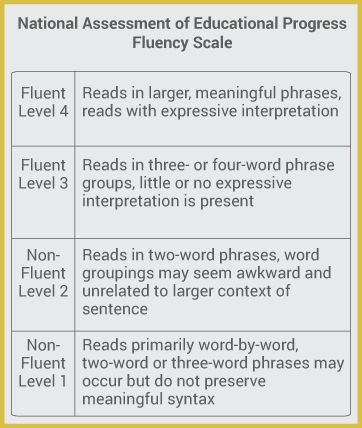“Fluency is defined as the ability to read with speed, accuracy, and proper expression. In order to understand what they read, readers must be able to read fluently whether they are reading aloud or silently. When reading aloud, fluent readers read in phrases and add intonation appropriately.”
Reading Rockets
Fluency: The Canary in the Reading Coal Mine
The Importance of Reading Fluency —
More than Speed
Educators and reading researchers agree that fluency is a key indicator of reading proficiency. Teachers use reading fluency tests, measured in Words Correct per Minute (WCPM) read, as an extremely time-efficient and reliable way to track students’ reading progress and their overall reading ability.  These simple timed reading tests can act as a warning system for educators and parents that the student is struggling with visually processing the text. A reading research team led by Dr. Lynn Fuchs states that “Teachers can and should use WCPM as their canary in the coal mine — their first indicator that all may not be well with their students’ reading ability.”
These simple timed reading tests can act as a warning system for educators and parents that the student is struggling with visually processing the text. A reading research team led by Dr. Lynn Fuchs states that “Teachers can and should use WCPM as their canary in the coal mine — their first indicator that all may not be well with their students’ reading ability.”
Many people find it shocking that a one-minute fluency evaluation can be so informative. It is an accurate and powerful indicator of overall reading competence; fluency strongly correlates with comprehension. Its validity and reliability have been well established in a body of research extending over the past 25 years. Improvements in the speed of accurate reading are valuable in saving time; but, the all-important goal of proficient reading is to increase the amount of content the reader can comprehend.
Tune Your Text to Increase Fluency
Teachers can use fluency as their canary in the reading coal mine — a first indicator that all may not be well with their students’ reading ability. Improving a student’s ability to visually process text has far-reaching benefits.
Readability Matters’ has proven that small modifications in Readability Features (size, character spacing and width, and line spacing) have an immediate impact on reading performance. Our mission is to work with technology and publishing companies to add readability features to their platforms so that students can increase their learning opportunities. Better readers are more confident and have more educational, career, and life opportunities.
Resources:
Oral Reading Fluency as an Indicator of Reading Competence: A Theoretical, Empirical, and Historical Analysis
Reading Fluency as an Indicator of Reading Comprehension
Reading fluency assessment and instruction: What, why, and how?
Screening, Diagnosing, and Progress Monitoring: The Details
Teaching Children to Read
Understanding and Assessing Fluency




